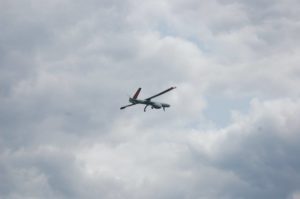
Late last month North Dakota State University (NDSU) launched an agricultural research project incorporating drone technology that was called “the first of its kind in the nation,” by Sreekala Bajwa, chair of NDSU’s Agricultural and Biosystems Engineering Department.
The project is the most recent effort by NDSU to determine the role of UAS in agricultural production and help strengthen the state’s economy. The efforts were initiated in 2014 with a project that used drones equipped with thermal infrared sensors and cameras to gather data from crop and livestock research projects at NDSU’s Carrington Research Extension Center.
The current project flies a Hermes 450 from Elbit, a small roto-copter and fixed-wing UAS to capture image data of a four- by 40-mile corridor in east-central North Dakota. The plan calls for collecting data every two weeks during the 2016 crop-growing season.
The Elbit Hermes 450 is an industrial strength rotocopter drone and has a 35 foot wingspan. It will collect images from altitudes of 3,000, 5,000 and 8,000 feet, while the small UAS will fly at 400 feet or below.
Smaller drones such as those made by DJI and 3DR have proven useful in crop and livestock production; but scientists at the North Dakota Agricultural Experiment Station and NDSU Extension Service specialists believe larger UAS can play an important role also.
“Small UAS are ideal for scouting crops and livestock, and can be used effectively to capture imagery for precision management decisions such as variable-rate in-season fertilization, weed identification, livestock inventory and identifying sick animals,” says John Nowatzki, Extension agricultural machine systems specialist and the principal investigator on this project. “But small UAS are relatively limited by flight time and cannot easily capture imagery of thousands of acres on the same day,” he adds. “Large UAS will be needed to collect high-spatial and temporal-resolution imagery over entire regions in a timely manner.”
“Most small UAS need to capture hundreds of individual images to make a single mosaicked image of one square mile,” Nowatzki says. “A large UAS could capture high-resolution imagery of one square mile in a single image. This would make it possible to capture imagery useable for precision crop management over hundreds of thousands of acres in a single day at very high resolution.”
The project will use the drones to collect data on stand counts in corn, sunflowers and sugar beets; the effectiveness of nitrogen applied to corn and wheat; iron chlorosis deficiency in soybeans; and yield predictions for corn, soybeans, wheat, sugar beets and sunflowers. Researchers plan to test whether UAS also can benefit livestock producers, such as by inventorying cattle in pastures.
Goals include: comparing data collected from by UAS at various altitudes with that collected through satellite imagery, in-field observations and on-the-ground sensors, detailed soil analyses and harvest yield information, assessing costs associated with collecting UAS imagery, including personnel, transportation, the number of flights required to gather sufficient data, the time required to collect the information, area of coverage per flight and maintenance costs per hour of flight to determine whether using UAS for agricultural purposes is economical.
Information from the project will be shared with Elbit and the FAA. The FAA recently approved the Hermes 450’s flight as part of the Northern Plains UAS Test Site in North Dakota. The state was selected in 2013 as one of six FAA test sites and is conducting research that will assist the FAA in developing those standards.
This is another example of North Dakota’s aggressive interest and investment in drone technology. In a message to DroneLife Brian Opp, Manager of Aerospace Business Development for the North Dakota Department of Commerce states, “The North Dakota State University and Elbit Systems of America collaboration is another example of North Dakota being on the cutting edge of the UAS industry. North Dakota strives to collaborate with and meet the needs of businesses. That is one of the reasons we are recognized as a leader in the UAS industry in the United States.”
Frank Schroth is editor in chief of DroneLife, the authoritative source for news and analysis on the drone industry: it’s people, products, trends, and events.
Email Frank
TWITTER:@fschroth